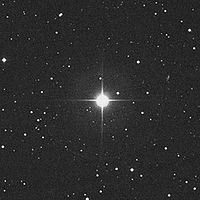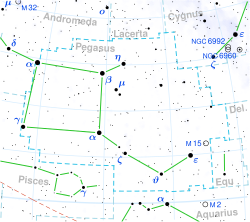51 Pegasi
51 Pegasi (abbreviated 51 Peg) is a Sun-like star located 50.9 light-years (15.6 parsecs)[1] from Earth in the constellation Pegasus. It was the first extrasolar Sun-like star found to have a planet orbiting it.[10]
Properties

The star is of apparent magnitude 5.49, and so is visible with the naked eye under suitable viewing conditions. The Flamsteed designation for this star, 51 Pegasi, was assigned by John Flamsteed in his star atlas published in 1712.
51 Pegasi has a stellar classification of G5V,[3] indicating that it is a main sequence star that is generating energy through the thermonuclear fusion of hydrogen at its core. The effective temperature of the chromosphere is about 5571 K, giving 51 Pegasi the characteristic yellow hue of a G-type star.[11] It is estimated to be 6.1–8.1 billion years old, somewhat older than the Sun, with a radius 24% larger and 11% more massive. The star has a higher proportion of elements other than hydrogen/helium compared to the Sun; a quantity astronomers term a star's metallicity. Stars with higher metallicity such as this are more likely to host planets.[3] In 1996 astronomers Baliunas, Sokoloff, and Soon measured a rotational period of 37 days for 51 Pegasi.[12]
Although the star was suspected of being variable during a 1981 study,[13] subsequent observation showed there was almost no chromospheric activity between 1977 and 1989. Further examination between 1994 and 2007 showed a similar low or flat level of activity. This suggests that the star may be in a Maunder minimum period during which a star produces a reduced number of star spots. Typically, a star with a close-in massive planet such as this will show a higher level of X-ray emission, but this is not the case for 51 Pegasi.[3]
Planetary system

On October 6, 1995, Michel Mayor and Didier Queloz announced the discovery of an exoplanet orbiting 51 Pegasi.[10] The discovery was made with the radial velocity method at the Observatoire de Haute-Provence, using the ELODIE spectrograph. On October 12, 1995, confirmation came from Dr. Geoffrey Marcy from San Francisco State University and Dr. Paul Butler from the University of California, Berkeley using the Hamilton Spectrograph at the Lick Observatory near San Jose in California.
51 Pegasi b (51 Peg b) is the first discovered planetary-mass companion of its parent star. The planet has been informally named Bellerophon. After its discovery, many teams confirmed its existence and obtained more observations of its properties, including the fact that it orbits very close to the star, suffers estimated temperatures around 1200°C, and has a minimum mass about half that of Jupiter. At the time, this close distance was not compatible with theories of planet formation and resulted in discussions of planetary migration. As of 2012, no additional planets have been found orbiting this star.
| Companion (in order from star) |
Mass | Semimajor axis (AU) |
Orbital period (days) |
Eccentricity | Inclination | Radius |
|---|---|---|---|---|---|---|
| b | ≥ 0.472 ± 0.039 MJ | 0.0527 ± 0.0030 | 4.230785 ± 0.000036 | 0.013 ± 0.012 | — | — |
See also
|
|
References
- ^ a b c d e f van Leeuwen, F. (2007). "Validation of the new Hipparcos reduction". Astronomy and Astrophysics. 474 (2): 653–664. Bibcode:2007A&A...474..653V. doi:10.1051/0004-6361:20078357.
{{cite journal}}: Unknown parameter|month=ignored (help) - ^ a b c d van Belle, Gerard T.; von Braun, Kaspar (2009). "Directly Determined Linear Radii and Effective Temperatures of Exoplanet Host Stars". The Astrophysical Journal. 694 (2): 1085–1098. Bibcode:2009ApJ...694.1085V. doi:10.1088/0004-637X/694/2/1085.
{{cite journal}}:|format=requires|url=(help); Unknown parameter|arXiv=ignored (|arxiv=suggested) (help) - ^ a b c d e f Poppenhäger, K.; et al. (2009), "51 Pegasi - a planet-bearing Maunder minimum candidate", Astronomy and Astrophysics, 508 (3): 1417–1421, Bibcode:2009A&A...508.1417P, doi:10.1051/0004-6361/200912945
{{citation}}: Unknown parameter|month=ignored (help) - ^ a b c d e Monet, David G.; et al. (2003). "The USNO-B Catalog". The Astronomical Journal. 125 (2): 984–993. arXiv:astro-ph/0210694. Bibcode:2003AJ....125..984M. doi:10.1086/345888.
{{cite journal}}: Unknown parameter|month=ignored (help) - ^ a b Johnson, H. L.; et al. (1966). "UBVRIJKL photometry of the bright stars". Communications of the Lunar and Planetary Laboratory. 4 (99). Bibcode:1966CoLPL...4...99J.
- ^ a b Frasca, A.; et al. (2009). "REM near-IR and optical photometric monitoring of pre-main sequence stars in Orion. Rotation periods and starspot parameters". Astronomy and Astrophysics. 508 (3): 1313–1330. Bibcode:2009A&A...508.1313F. doi:10.1051/0004-6361/200913327.
{{cite journal}}: Unknown parameter|month=ignored (help) - ^ Simpson, E. K.; et al. (2010), "Rotation periods of exoplanet host stars", Monthly Notices of the Royal Astronomical Society, 408 (3): 1666–1679, Bibcode:2010MNRAS.408.1666S, doi:10.1111/j.1365-2966.2010.17230.x
{{citation}}: Unknown parameter|month=ignored (help) - ^ Mamajek, Eric E.; Hillenbrand, Lynne A. (2008). "Improved Age Estimation for Solar-Type Dwarfs Using Activity-Rotation Diagnostics". The Astrophysical Journal. 687 (2): 1264–1293. Bibcode:2008ApJ...687.1264M. doi:10.1086/591785.
{{cite journal}}: Unknown parameter|month=ignored (help) - ^ "51 Peg – Star suspected of Variability". SIMBAD. Centre de Données astronomiques de Strasbourg. Retrieved 2011-12-17.
- ^ a b Mayor, Michael; Queloz, Didier (1995). "A Jupiter-mass companion to a solar-type star". Nature. 378 (6555): 355–359. Bibcode:1995Natur.378..355M. doi:10.1038/378355a0.
- ^ "The Colour of Stars", Australia Telescope, Outreach and Education, Commonwealth Scientific and Industrial Research Organisation, December 21, 2004, retrieved 2012-01-16
- ^ Baliunas, Sallie; Sokoloff, Dmitry; Soon, Willie (1996). "Magnetic Field and Rotation in Lower Main-Sequence Stars: An Empirical Time-Dependent Magnetic Bode's Relation?". The Astrophysical Journal Letters. 457 (2): L99–L102. Bibcode:1996ApJ...457L..99B. doi:10.1086/309891..
- ^ Kukarkin, B. V.; et al. (1981). Nachrichtenblatt der Vereinigung der Sternfreunde e.V. (Catalogue of suspected variable stars). Moscow: Academy of Sciences USSR Shternberg. Bibcode:1981NVS...C......0K.
- ^ Butler, R. P.; et al. (2006). "Catalog of Nearby Exoplanets". The Astrophysical Journal. 646 (1): 505–522. arXiv:astro-ph/0607493. Bibcode:2006ApJ...646..505B. doi:10.1086/504701.
External links
- Jean Schneider (2011). "Notes for star 51 Peg". Extrasolar Planets Encyclopaedia. Retrieved 3 October 2011.
- Extrasolar Visions: 51 Pegasi
- 51 Pegasi at SolStation.com.
- nStars database entry
- David Darling's encyclopedia

